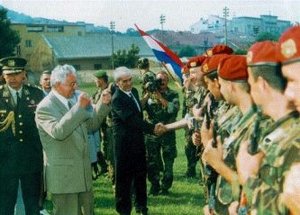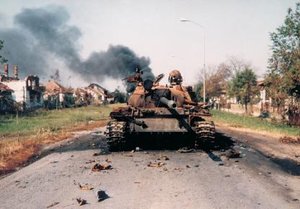History of modern Croatia
|
|
| This article is part of the History of Croatia series. |
| Before the Croats |
| Medieval Croatian state |
| Union with Hungary |
| Habsburg Empire |
| First Yugoslavia |
| Croatia during WWII |
| Second Yugoslavia |
| Modern Croatia |
The modern period in Croatian history begins with the country's independence in 1991.
War of Independence (Homeland War)
The new Croatian Government pursued its policy of gradual secession from Yugoslavia, and it was gravely concerned about the rebellion in Krajina. The Ministry of the Interior started arming an increasing amount of special police forces. The Yugoslav People's Army (JNA) tried to forcefully maintain the status quo, and the new nation started building a real army to counter it. On April 9th, 1991, Croatian President Tuđman ordered that the special police forces are to be renamed Zbor Narodne Garde ("People's Guard"), marking the creation of a separate military of Croatia.
On the 19th of May, 1991, Croatian authorities held a referendum about the secession from Yugoslavia. Serbian local authorities in Krajina called for a boycott, and the referendum passed with 94.17% in favor. Croatia declared independence from Yugoslavia on June 25th, 1991, but the European Commission urged them to place a three-month moratorium on the decision.
One month after the declaration of independence, Serbian forces held about one third of the country, as they were actually already equipped for war. Given their prevalence in weaponry, their military strategy mostly consisted of extensive shelling, including civilian targets. As the war progressed, the cities of Dubrovnik, Šibenik, Zadar, Karlovac, Sisak, Slavonski Brod, Osijek, Vinkovci and Vukovar all came under the attack of the Serbian forces.
In August 1991, the siege started on the border city of Vukovar. The Serbian troops eventually completely surrounded the city but the defenders, the 204th Vukovar Brigade, entrenched within Vukovar and held their ground fearing what would happen to the many civilians who took shelter in the city.
The civilian population fled the areas of armed conflict en masse: generally speaking, Croats moved away from the Bosnian and Serbian border, while the Serbs moved towards it. Some estimates include 220,000 Croats and 300,000 Serbs internally displaced during the war in Croatia, although at the peak of fighting in late 1991, around 550,000 people temporarily became refugees on the Croatian side. The 1991 census data and the 1993 RSK data for the areas of Krajina differ by some 102,000 Serbs and 135,000 Croats. In many places, masses of civilians were forced out by the military, in what became known as ethnic cleansing.
President Tuđman made a speech on October 5th, 1991 that called upon the whole population to mobilize and defend from what he deemed "Greater-Serbian imperialism" on Croatia pursued by the JNA and the Serbian paramilitary formations. On October 7th, an explosion happened in the government headquarters in Zagreb while Tuđman, Mesić and Marković were there, for which the government claimed was a JNA air raid, which JNA denounced and claimed that the explosion was set up by the government. The next day, Croatian Parliament cut all remaining ties with Yugoslavia. October 8 is now Independence day in Croatia.
In the meantime, the war was reaching its peak. According to the commanding officers of Vukovar's 204th brigade, they destroyed or damaged 350-400 armored vehicles, destroyed 50 airplanes, killed 14,000 enemy soldiers and wounded another 30,000. The figures from Serbian sources are smaller by about 10-15 percent. In one hundred days of the battle for Vukovar, the Croatian forces inflicted over 50% of the total casualties and weaponry destruction to the JNA in the whole war.
By November, Vukovar was almost completely destroyed and overwhelmed by Serbian forces and Croats finally surrendered on November 18th, 1991. Allegedly this was done in an attempt to prevent further devastation of Dubrovnik and other cities. In the aftermath of the occupation, the Serbian forces committed atrocities for which their commanders (Mile Mrkšić, Miroslav Radić, Veselin Šljivančanin) and collaborators in the city (Slavko Dokmanović) were and are on the trial at the ICTY.
On December 19, 1991, during the heavy fighting, the Serbian Autonomous Regions in Krajina and western Slavonia were officially proclaimed to be the Republic of Serbian Krajina. Between December 19 and December 23, several European countries recognized Croatia's (and Slovenia's) independence, including Germany, the first EEC country to do so. Some, including successive US Secretaries of State Lawrence Eagleburger and Warren Christopher, have strongly criticized this action, which they say escalated the war. Others claimed that by doing nothing and imposing an arms embargo on the seceding republics, Western nations silently encouraged the Serbian rampage across Yugoslavia. The EEC as a whole recognized the independence of the two breakaway republics on January 15th, 1992.
January 1992 also brought a UN-sponsored cease-fire, and the warring parties mostly entrenched as the United Nations Protection Force was deployed to maintain cease-fire. The Yugoslav People's Army soon retreated from Croatia into Bosnia and Herzegovina where war was just about to start. During 1992 and 1993, an estimated 225,000 Croats from Bosnia and also from Serbia took refuge in Croatia. A large number of Bosniaks also fled to Croatia.
Croatia became a member of the United Nations on May 22, 1992. Armed conflict in Croatia remained intermittent and mostly on a small scale. An unsuccessful Operation Medak pocket in 1993 made a dent on the new country's international reputation, and the ICTY would later investigate Croatian officers Janko Bobetko, Ante Gotovina and others regarding crimes committed during this operation.

In early May 1995, Croatian army retook a large patch of territory in western Slavonia in Operation Flash. In August same year, Croatia started Operation Storm and quickly took most of RS Krajina, except for a small strip near the Serbian border. In just four days, about 140,000 Serbs fled to Bosnia and Serbia.
The Croatian army proceeded to fight Serbs in Bosnia alongside the Bosniaks, but further advances were prevented by a US diplomatic intervention. Had the Croat army occupied the second largest Bosnian town of Banja Luka, the refugee crisis would have become unbearable since tens of thousands of people would run further east through the narrow Posavina corridor towards eastern Bosnia and Serbia. Overall, the 2001 census showed around 380,000 less Serbs in Croatia compared to the census of 1991.
A few months later, the war ended upon the negotiation of the Dayton Agreement (in Dayton, Ohio) which would later be signed in Paris in December 1995.
Post-war period
Croatia became a member of the Council of Europe on November 6, 1996. 1996 and 1997 were a period of post-war recovery and favorable economic conditions.
The remaining part of RS Krajina, areas adjacent to Yugoslavia, became a protectorate of the UN Transitional Administration for Eastern Slavonia, Baranja and Western Sirmium. It was formally peacefully re-integrated into Croatia on January 15th, 1998.
Tuđman died in 1999 and the nationalist HDZ government was replaced by a center-left coalition, with Ivica Račan as a prime minister, in early 2000 during parliamentary elections. At the same time, presidential elections were held which were won by a moderate, Stjepan Mesić.
The country rebounded from a mild recession experienced in 1998/1999 and achieved notable economic growth in the following years. Unemployment would continue to rise until 2001 when it finally started falling. Refugee return accelerated as many homes were rebuilt by the government; most Croats had already returned (except for some in Vukovar), whereas only a third of the Serbs returned, impeded by unfavourable property laws, ethnic problems and economic issues.
Croatia became a World Trade Organization (WTO) member on November 30, 2000. The country signed an Association Agreement with the European Union in October 2001, and applied for membership in the Union in February/March 2003.
In late 2003, new elections were held and a reformed HDZ party won under leadership of Ivo Sanader, who became the prime minister. Following further controversy over extradition of army generals to the ICTY, in 2004 the European Commission finally issued a recommendation that the accession negotiations with Croatia should begin. Its report on Croatia described it as a modern democratic society with a competent economy and the ability to take on further obligations, provided it continues the reform process.
The country was given applicant status on June 18, 2004 and a negotiations framework in March 2005. The actual negotiations are still stalled, however, because of issues with the ICTY. Croatian government and the European leaders plan for Croatia to become a member of the EU either together or soon after Romania and Bulgaria, i.e. between 2007 and 2009.

